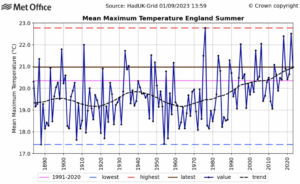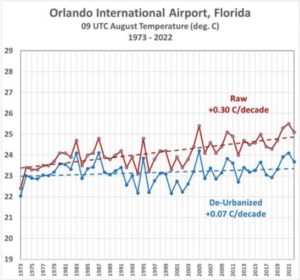BBC Uses Corrupted Airport Data to Circulate Scares About “Extreme Heat” and Climate Change
The beginning of May saw a dramatic illustration of how far parts of the mainstream media has departed from the scientific process in its aim to catastrophise the climate and push society to accept the global Net Zero collectivisation. “London seeing more days above 30°C, experts say”, ran a BBC headline, with a reported suggestion that London must adapt to the “new reality”. But it turns out that the ‘experts’ have used “airport data for consistency across worldwide cities, including City Airport in London”. It is difficult to think of a more unsuitable dataset to promote notions of “extreme heat”, other than perhaps to take measurements next to the door of a blast furnace.

Similar versions of the story appeared in numerous mainstream outlets including Sky and the Independent suggesting the material was subbed from a circulated release. It originated from the International Institute for Environment and Development (IIED,) a green activist think tank that collects funding from a wide variety of governmental and private sources. The analysis is said to be part of a larger project to look at how “climate change” is affecting the world’s most populated cities. Sky said the IIAD report was just one in a raft of warnings in the last year, “about the pressing need to adapt the country to climate change”. IIED researcher Tucker Landesman claimed it was clear that the “extreme heat is here to stay and London needs to adapt soon to remain liveable for everyone”.
Landesman is an urban studies graduate from the LSE and he appears big on woke woo-woo. Connecting decarbonisation and social justice and Towards queer-centred urban development, are two of his recent publications. Tucker is said to be “particularly interested in intersectional approaches to urban poverty and inequality”. No doubt these are his areas of expertise, but in collating measurements next to the exhausts of multiple jet aircraft for the purpose of making predictions of Thermogeddon, he would appear to be operating outside his comfort zone. Given what scientists have discovered about the urban heat effect, and its dramatic short-term effect on temperature measurements, it is difficult to understand why the BBC is giving house room to this ‘new analysis’. Having to pass through airports that are noticeably hotter than surrounding areas in air-conditioned buildings is hardly front page news – unless, of course, there is some pseudoscientific agenda at work.
The use of data from unsuitable sites has bedevilled the recent collection of accurate temperature measurements in most meteorological operations around the world. Earlier this year, the Daily Sceptic revealed that nearly eight out of ten of the U.K. Met Office’s measuring sites had huge scientifically-designated ‘uncertainties’ that effectively disqualified them from providing accurate data. Despite such large potential corruptions, the Met Office was able to claim to a hundredth of a degree that last year in the U.K. was only 0.06°C cooler than the year before.
The World Meteorological Organisation rates weather sites from class 1 to 5 based on the amount of human-caused heat corruption that is likely to occur next to the measuring devise. Class 4 comes with ‘uncertainties’ of 2°C and these accounted for 48.7% of the Met Office’s 380 recording stations. Class 5 comes with ‘uncertainties’ of 5°C and these applied to 29.2% of the total, with many of the stations set down the runways at local airports. For instance, frequent reference is made to high readings at the class 5 military airport at Northolt.
The BBC report claims that “really extreme temperatures” have become more frequent with seven days above 35°C in the past three decades, five of which occurred within the last five years, statistics from 1994-2023 show. Statistics also show that passenger numbers at the enlarged City Airport tripled over that period, although numbers are still well down on the years before Covid.

According to the official Met Office figures, which as we have seen need taking with plenty of salt, there has been a small rise in the average summer maximum temperature since the mid 1990s. It is about 0.8°C, but the recent rise is only 1.2°C higher than the averaged maximums recorded in the less urban heat corrupted records from around 90 years ago. Given that the global temperature has been gently warming over the last 150 years as a recovery from the Little Ice Age, this is not surprising. What would have been considered a ‘nice’ summer in the mid 1930s is now, one degree centigrade later, promoted in politicised alarmist terms with weather maps painted in hellish reds and purples.
In 2022, an insight into the heat corruptions at airports was provided by two former NASA scientists working out of the University of Alabama in Huntsville. Dr. Roy Spencer and Professor John Christy found massive human-caused heat distortions in the temperature record across the United States. Airports were found to be particularly prone to higher temperatures compared with those recorded in surrounding less urbanised areas.

The most dramatic finding occurred at Orlando airport where decadal warming since 1973 of 0.3°C is slashed to just 0.07°C after the data has been ‘de-urbanised’. The number of passengers has soared in recent years with over 50 million people passing through the ever-growing airport, the gateway to Mickey Mouse and the Magic Kingdom. Interestingly, the divergence between the two temperature datasets becomes more pronounced from the turn of the century.
Unsurprisingly, many of the Met Office’s heat ‘records’ have been recorded since the turn of the century. Almost all of them are from ‘junk’ class 5 and ‘near junk’ class 4 sites. Class 5 maximum temperature records, with their ‘uncertainties of 5°C, have been declared in Northern Ireland and three U.K. areas. The record in Central S was measured in St. James’s Park in London, site of one of the five 40°C plus recordings of July 19th, 2022. Class 4 record holders are even more numerous with the highest Scottish record set at Charterhall. Hawarden Airport is home to the highest Welsh recording. No less than five U.K. areas have records attributed to this class which comes with ’uncertainties’ of 2°C.
And, of course, who can forget the national joke record of 40.3°C declared on July 19th, 2022 at Coningsby – or more accurately, RAF Coningsby. Blink and you might have missed it since the 60-second record was caused by a 0.6°C spike either side of 3.12pm. As it occurred, it appears that no less than three typhoon fighter jets were landing at or near that time.
yogaesoteric
May 23, 2024
